Chicken And Dumplings Recipe
This Chicken and Dumplings recipe is the kind of dish that feels like home in every bite—humble, hearty, and deeply nourishing. Built from a slow-simmered stew of whole chicken, root vegetables, and fragrant herbs, it captures the essence of old-fashioned comfort food while still offering wholesome touches like whole wheat flour and cornmeal dumplings.
The broth is gently thickened into a rustic gravy, tender potatoes and carrots absorb the savory richness, and soft dumplings steam to fluffy perfection right on top of it all.
Whether served on a chilly evening or as a soul-soothing centerpiece for a family dinner, this dish is a reminder that simple, slow-cooked food can be as restorative as it is satisfying.
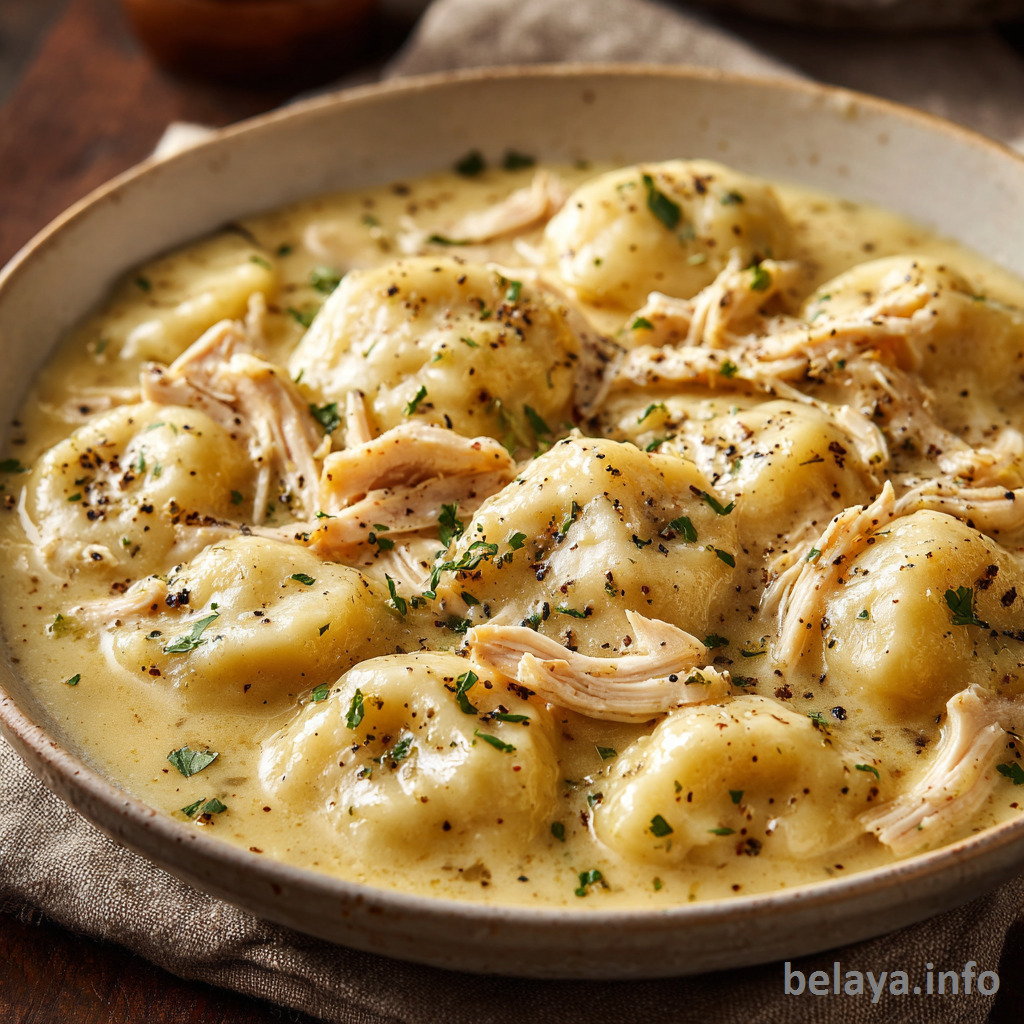
Why People Will Love the Chicken and Dumplings recipe:
Nostalgic and Heartwarming: This dish brings back the flavors of classic home cooking—like something passed down from a grandmother’s kitchen—making it emotionally comforting as well as physically satisfying.
Balanced and Hearty: With lean chicken, fiber-rich vegetables, and whole grain dumplings, it delivers a wholesome meal in one pot—both nourishing and filling.
Slow-Simmered Flavor: Cooking the whole chicken with herbs and vegetables creates a deeply savory broth that’s rich in natural collagen and layered with homemade taste.
Fluffy Cornmeal Dumplings: The dumplings are soft, subtly textured from cornmeal, and steam directly over the stew—soaking up the flavors while adding a rustic, pillowy finish.
Versatile and Family-Friendly: It’s easy to adapt based on what you have on hand, and the comforting textures and mild seasoning appeal to both kids and adults alike.
One-Pot Simplicity: Despite its depth of flavor, it’s made in a single pot, making cleanup easy and meal prep streamlined—perfect for busy weeknights or leisurely weekends.
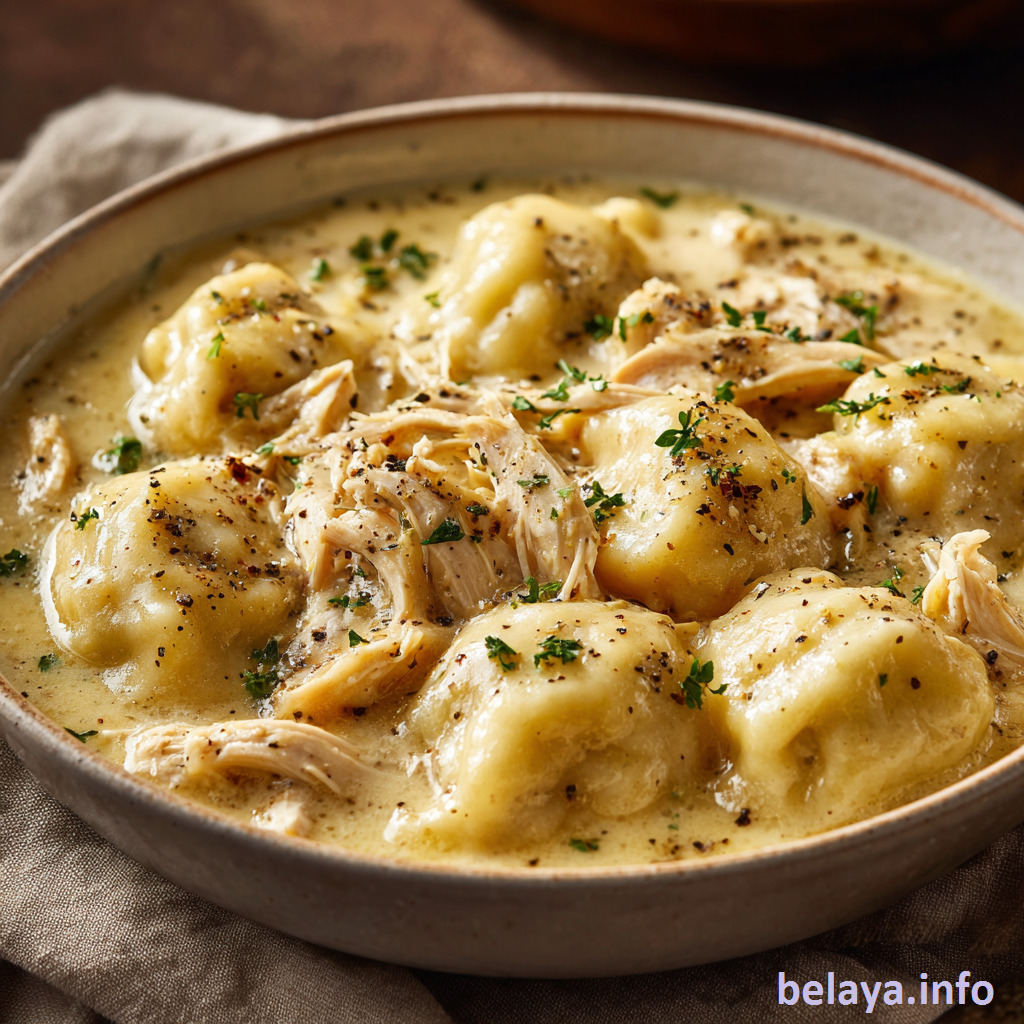
Key Ingredients:
Whole Chicken: Using a whole chicken provides rich, layered flavor as it slowly simmers with the skin, bones, and meat—infusing the broth with natural depth, nutrients, and body that boneless cuts can’t replicate.
Root Vegetables (Carrots, Potatoes, Celery): These hearty staples add earthiness and texture to the stew. Carrots offer natural sweetness, potatoes bring starch and structure, and celery delivers an aromatic foundation.
Onions, Bay Leaf & Fresh Rosemary: This classic trio builds the aromatic backbone of the broth. Onions provide depth, bay leaf lends a subtle bitterness, and rosemary adds a warm, woodsy fragrance that lingers in each spoonful.
Whole Wheat Flour & Cornmeal (for Dumplings): These create a denser, more rustic dumpling than refined white flour—adding both fiber and a nutty, textured bite that complements the richness of the stew.
Milk & Olive Oil (Dumpling Moisture): The milk softens the dough, while extra virgin olive oil lends tenderness and a hint of fruitiness that elevates the dumplings beyond standard fare.
Frozen Peas: Stirred in at the end for a pop of color and subtle sweetness, peas lighten the dish and round out its flavor profile without overwhelming its rustic heart.
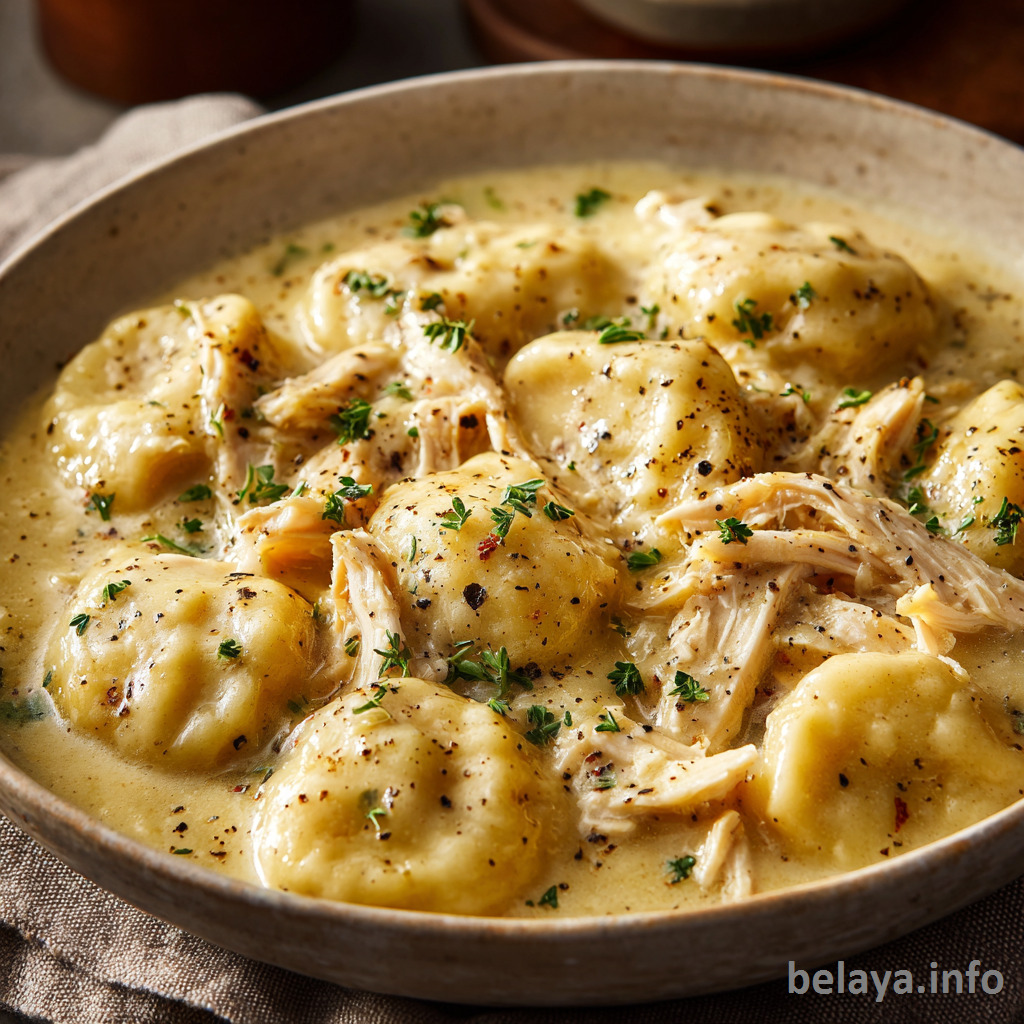
Expert Tips:
Simmer the Chicken Low and Slow: Using a whole chicken simmered on low heat allows collagen to break down gently, enriching the broth with body and natural gelatin, resulting in a velvety texture and deeply savory flavor.
Keep the Skin and Bones During Cooking: Don’t remove the skin and bones before simmering—they add richness and depth to the broth. Remove them only after cooking to retain full flavor and nutritional value.
Quarter Vegetables Uniformly: Cutting the potatoes and carrots into uniform chunks ensures even cooking and maintains their texture during long simmering—no mushy vegetables here.
Enhance the Roux With Broth, Not Water: When thickening the stew, use hot broth from the pot instead of plain water to avoid diluting flavor and to create a seamless, savory thickener.
Avoid Overmixing the Dumpling Dough: Stir the dumpling mixture just until moistened. Overmixing develops too much gluten, resulting in dense, chewy dumplings rather than light, fluffy ones.
Steam, Don’t Boil Dumplings: Once the dumplings are in, do not lift the lid during steaming. Letting out the steam prematurely can collapse them or leave them undercooked in the center.
Use Fresh Herbs for Finish: While rosemary infuses the broth early, adding fresh chopped parsley or thyme at the end brightens the dish and balances the richness with fresh aromatics.
Rest the Stew Before Serving: Let the pot sit off-heat for 5–10 minutes after cooking. This allows the flavors to settle and makes the dumplings easier to serve intact.
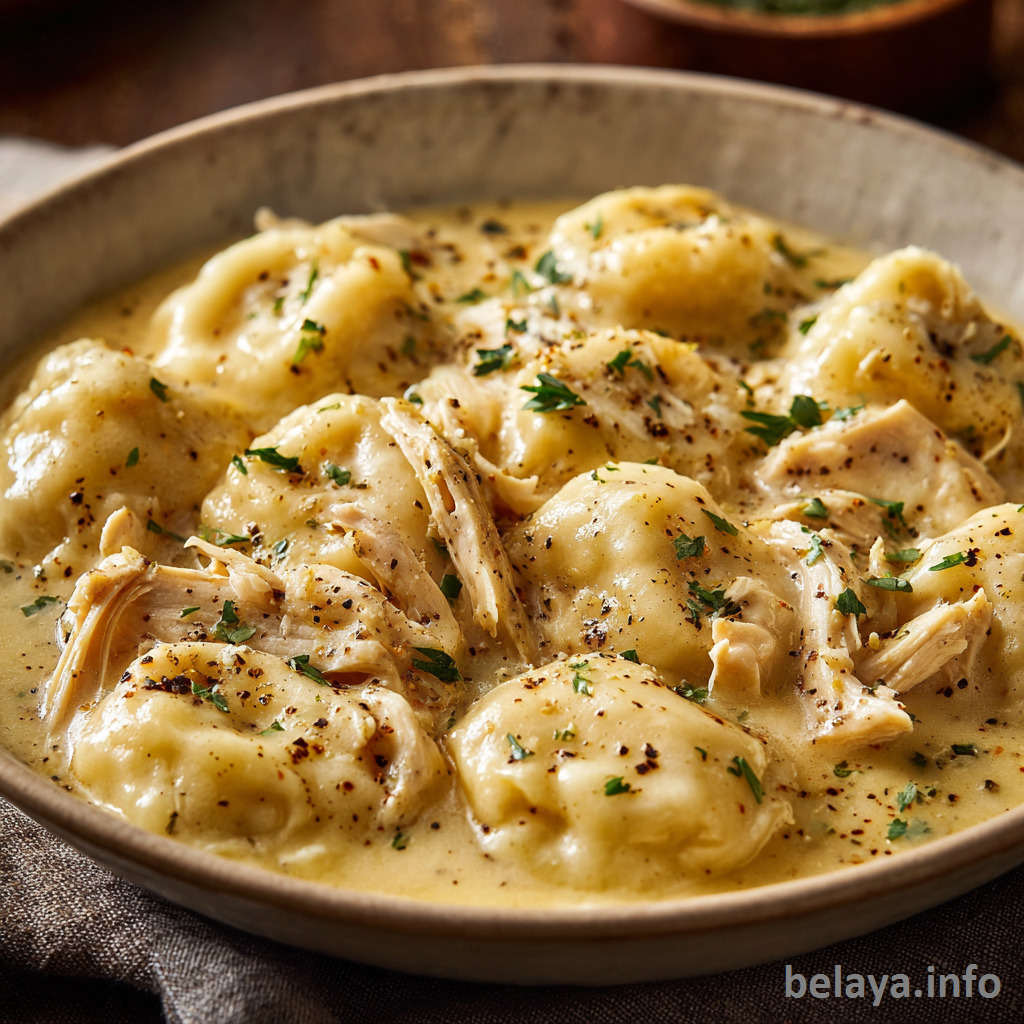
Chicken And Dumplings Recipe
Ingredients
Chicken stew
2 ½ lb whole chicken
6 carrot(s), peeled
1 cup celery, sliced
6 potato(es), medium, with skin
1 cup onion(s)
1 bay leaf
1 sprig rosemary, fresh, fresh
6 cups water
1 cup frozen peas
3 tbsp. tablespoon whole wheat flour
½ tsp. black pepper
½ t. salt
2 tbsp. 1 tbsp cold water Dumplings
¼ cup cornmeal (polenta)
1 cup whole wheat flour
2 tbsp. yeast
½ cup 2% milk
2 tbsp. tablespoon olive oil, extra virgin
Instructions:
Slice the celery and chop the onions. Place in a large pot with lid. Add bay leaf, rosemary, chicken and water and simmer, covered, for 45 minutes or until chicken is fully cooked and easy to pull off the bone.
Remove the chicken from the heat and let cool. Remove and discard the skin and cut the chicken into pieces with the bones. Discard the bay leaf.
Washing potatoes and cut to quarters . Cut the carrots into quarters (or halves depending on size) lengthwise and add the vegetables and the salt and black pepper to the hot broth in the pot with the chicken. Simmer, covered, for 25 minutes or until potatoes are tender.
For more thickness, mix the flour with cold water to form a smooth dough. Add hot broth to this roux and stir it into the stew. Simmer for another 5 minutes to thicken the liquid. Add frozen peas to stew.
To make the dumpling, combine the flour, cornmeal and baking powder in a bowl. Pour in the milk and oil until the mixture is moist.
Slip 6 scoops (about ¼ cup – 60 mL each) of the dumpling batter into the simmering stew.
Put the lid on and simmer over low heat for 15 minutes or until the dough does not stick to a toothpick inserted in the middle of the dumpling. Avoid lifting the lid during cooking as the dumplings must steam.
Enjoy !
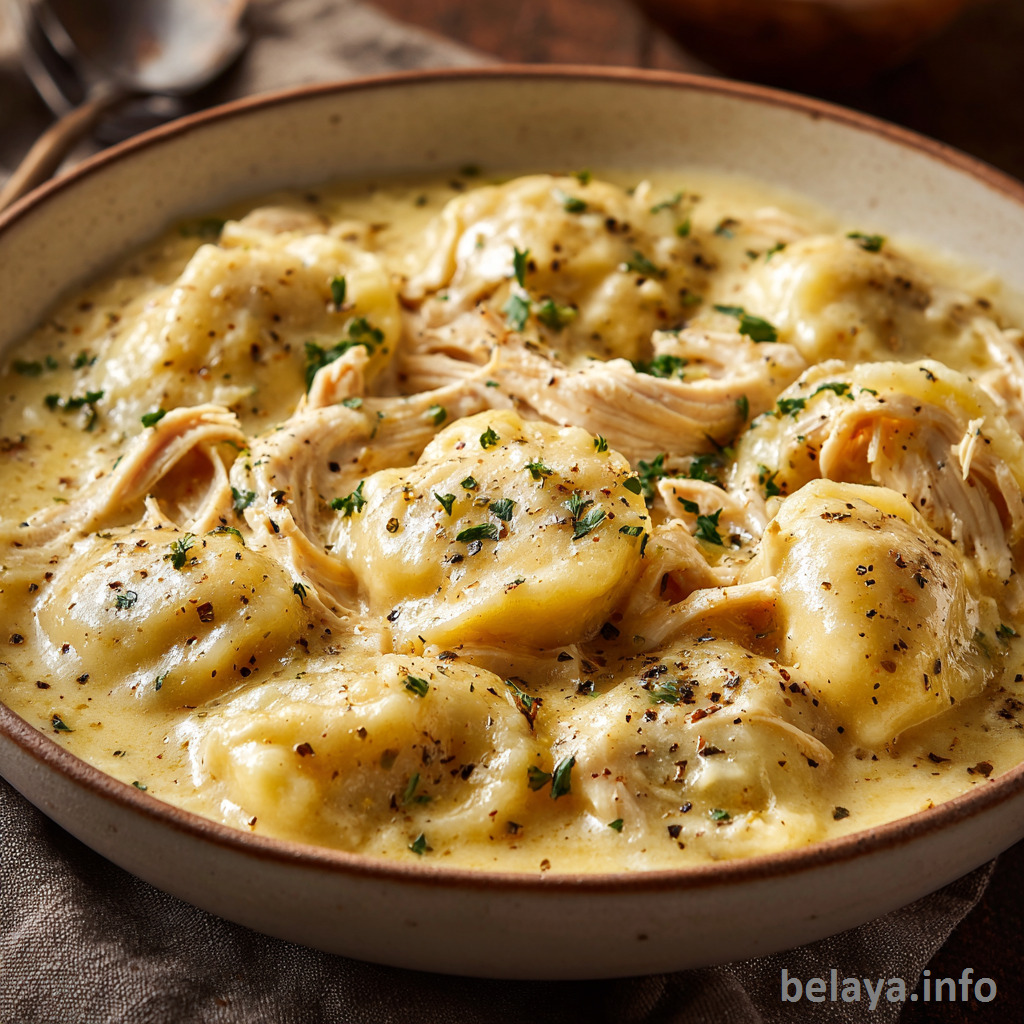
Important Notes When Making Chicken And Dumplings Recipe
Use Bone-In Chicken for Deeper Flavor
Simmering a whole chicken (with bones) extracts collagen and richness, producing a deeply savory broth that’s hard to replicate with boneless meat.
Don’t Skip the Aromatics
Fresh rosemary, bay leaf, and onion add essential earthy and herbal notes. Remove herbs before serving to avoid bitterness.
Timing the Vegetables is Key
Add carrots and potatoes after the chicken is mostly cooked. This prevents overcooking and ensures the veggies remain fork-tender, not mushy.
Thickening Tip for a Silky Broth
The flour-water roux added at the end enhances body without making the broth overly heavy. Whisk smooth to avoid lumps, and temper it with hot broth before stirring in.
Dumplings Require Gentle Steaming, Not Boiling
Keep the pot covered tightly when steaming dumplings. Lifting the lid releases heat and moisture, which can lead to undercooked or dense results.
Avoid Overmixing Dumpling Dough
Stir just until combined — overmixing activates gluten, which can lead to tough or chewy dumplings rather than soft and pillowy ones.
Let Chicken Cool Slightly Before Handling
Removing chicken from the broth and letting it rest for 5–10 minutes makes it easier (and safer) to handle while shredding or cutting.
Add Peas at the End
Peas retain their bright color and tender texture when added just before serving, avoiding dull or mushy results.
Season at Every Stage
Salt lightly when building the broth, and adjust seasoning again before serving. Vegetables and dumplings can dilute flavor without proper seasoning.

How To Enjoy Chicken and Dumplings After Cooking
Step 1: Let It Rest Briefly
Allow the stew to sit, uncovered, for 5–10 minutes after turning off the heat.
This lets the dumplings finish steaming and thickens the broth slightly as it cools.
Step 2: Prepare for Serving
Use a large ladle and wide soup bowls.
Gently scoop dumplings without tearing them and include a generous mix of chicken, vegetables, and broth.
Be sure each serving includes at least one dumpling, pieces of chicken, and a rich portion of the stew base.
Step 3: Garnish for Flavor & Appearance
Sprinkle freshly chopped parsley or thyme over the top for freshness and color.
A crack of black pepper or a drizzle of olive oil adds a final aromatic touch.
Serve with warm crusty bread or soft dinner rolls to soak up the broth.
Step 4: Add Optional Brightness
For a fresh contrast, offer lemon wedges or a spoonful of tangy sour cream on the side — it cuts through the richness beautifully.
A small salad with vinaigrette also pairs nicely if you want balance.
Step 5: Store Leftovers Wisely
Let the stew cool completely before storing.
Refrigerate in airtight containers for up to 4 days.
Freeze in portions (without dumplings for best texture) for up to 2 months. Add fresh dumplings when reheating.
Reheating Tips
Reheat gently over low-medium heat on the stove.
Add a splash of broth or water if the stew has thickened too much.
Cover with a lid while reheating to help dumplings stay moist and avoid drying out.
Step 6: Savor Slowly
This is classic comfort food — best enjoyed when you can sit, relax, and soak up the warmth.
Eat slowly and appreciate the hearty texture, rich broth, and fluffy dumplings. It’s a dish meant to soothe and satisfy.

Nutrition Information:
Per serving (based on approximately 1½ cups of the complete dish including chicken, vegetables, broth, and one dumpling):
Calories: 290 kcal | Total Fat: 9.4 g | Saturated Fat: 2.3 g | Monounsaturated Fat: 3.4 g | Polyunsaturated Fat: 2.1 g | Cholesterol: 65 mg |
Sodium: 410–480 mg (depending on salt and broth used) | Total Carbohydrates: 28 g | Dietary Fiber: 4.1 g | Sugars: 4.5 g | Protein: 25 g

Frequently Asked Questions:
Can I use boneless chicken instead of a whole chicken?
Yes, you can substitute boneless chicken thighs or breasts. However, using a whole chicken adds more depth to the broth due to the bones and skin. If using boneless cuts, consider adding a bit of store-bought chicken broth or bouillon for a richer flavor.
How do I keep the dumplings from becoming soggy or dense?
Avoid overmixing the dumpling batter, which can make them tough. Also, once the dumplings are added, keep the lid closed during the steaming process—lifting it lets steam escape and can disrupt their rise and texture.
Can I make this dish gluten-free?
Yes. Use a gluten-free flour blend in both the stew thickener and dumpling mix. Make sure your cornmeal and baking powder are labeled gluten-free as well. The texture of the dumplings may be slightly different but still delicious.
What vegetables can I add or substitute in this recipe?
In addition to carrots, peas, potatoes, and celery, you can add mushrooms, parsnips, or green beans for variety. Leafy greens like kale or spinach can also be stirred in at the end for extra nutrients.
Can I prepare this dish ahead of time?
Yes, the stew (without dumplings) can be made a day ahead and stored in the fridge. When ready to serve, reheat the stew and prepare fresh dumplings to cook directly in the hot broth. This ensures the dumplings are light, fluffy, and freshly steamed.
How do I know when the chicken is fully cooked?
The chicken is done when it reaches an internal temperature of 165°F (74°C) and easily pulls apart with a fork. For a whole chicken, simmering for about 45 minutes usually ensures it’s cooked through and flavorful.
What’s the best way to thicken the broth without clumps?
To prevent clumping, mix the whole wheat flour with cold water until smooth before adding hot broth. Stir this slurry into the pot slowly while whisking. Let it simmer for 5–10 minutes to activate the thickening.
Can I make the dumpling batter ahead of time?
It’s best to make the dumpling batter just before cooking so the leavening (from baking powder or yeast) stays active. If made too early, the dumplings may not rise properly and could turn out dense or flat.
Why can’t I lift the lid while the dumplings are steaming?
Keeping the lid closed traps steam, which is essential for the dumplings to rise and cook evenly. Lifting the lid can release steam, lower the temperature, and result in undercooked or soggy dumplings.
How do I avoid overcooking the vegetables?
Add sturdier vegetables like potatoes and carrots earlier in the cooking process. Add quicker-cooking ingredients like peas near the end to retain their color, texture, and nutrients. Timing is key to balanced doneness.